
When I first started working at CXL, my title was “content and growth marketer.”
The way my boss, Peep, put it, “you’ll write articles, but you’re not primarily a content writer. You’re a content marketer.“
At first, I didn’t know what that meant, but I eventually learned that the emphasis would be on content promotion and optimization.
I initially thought content promotion simply meant sharing your blog posts on social media and getting backlinks to drive search engine rankings. A content promotion strategy, however, is much more holistic than those simple tactics.
In this blog post, we’ll break down everything you need to know about creating a content promotion strategy that will help you achieve your business goals. By the end, you’ll have a clear plan of attack for promoting your content and driving results. Let’s get started!
Why You Need a Content Promotion Strategy (and What It Is)
Before we dive into how to create a content promotion strategy, let’s first take a step back and answer the question: what is a content promotion strategy?
In short, a content promotion strategy is an overarching plan for getting your content seen by as many people as possible (given constraints on your target audience and influencers). It takes into account all of the different channels and tactics you’ll use to promote your content, as well as how you’ll measure success.
If the content itself is the “what” of your content strategy, the content promotion focuses on the “who” – who will read this? Who will amplify this? And how will we get distribution?
Of course, there’s an innate tie in with content production and promotion, which I’ll cover in the strategies below.
Why is having a content promotion strategy so important? Because without one, you’re likely to:
- Promote your content on the wrong channels
- Waste time and money promoting your content ineffectively
- Miss out on opportunities to get your content in front of new audiences
- Have trouble measuring the ROI of your content marketing efforts
In other words, a solid content promotion strategy is essential if you want your content marketing program to be successful.
It prevents you from facing the “tree falls in the forest” problem. If you publish a piece of content and no one reads it, does it really exist? Even the best content in the world can fall on deaf ears if not properly promoted.
Creating and executing an effective content promotion strategy is essential if you want your content to reach a wide audience and generate leads for your business.
But with so many channels and options available, it can be hard to know where to start.
How To Create A Content Promotion Strategy in 10 Steps
- Start with Your Business Goals
- Understand Your Target Audience
- Research Your Competitors’ Promotional Tactics
- Identify Your Core Channels (or Go Where The Fish Are)
- Index on long term and short term channels
- Incorporate your promotion strategy into your content calendar
- Map Out Your Basic Workflow
- Set Up Tracking and Reporting
- Experiment and optimize
- Rinse and repeat
1. Start with Your Business Goals
The content you create should always be aligned with the business goals of your organization.
That’s why the first step to creating an effective content promotion strategy is to define your content marketing objectives and KPIs.
What do you hope to achieve with content marketing? What metrics will you use to measure success?
This step is important because it will inform the content you create and how you promote it.
The way I look at it, there’s a hierarchical ladder of goals starting at business goals, then mapping down to marketing goals, and then to content marketing goals.
Within content marketing goals, you can map out specific content promotion goals that are contributive to your overall content marketing program goals.
For example, if as a business you want to get to X revenue next year, marketing has to contribute Y leads.
Content marketing, to help you get there, is responsible for X% of those leads, but also to raise the overall brand awareness of your company to assist with the sales process.
If your primary growth channel within content is search, then you may have backlink goals for content promotion. You may also have non-organic traffic goals to help “step on the gas” to help you get to those organic goals.
The important thing is to map out these content marketing KPIs up front.
For us, we measure the number and velocity of backlinks as well as cost per link. We also measure the impressions and leads we get directly from LinkedIn and Twitter activity.
The proximate conversion goal for us is email list signups, and we split that by the source channel in Google Analytics. We set big annual goals and then chunk that up on a quarterly basis to make sure we’re on track.
2. Understand Your Target Audience
The next step is to understand who you are creating content for. Who is your target audience? Where do they hang out online? What content topics and formats do they engage with the most?
Answering these questions will help you focus on the right channels and content types when it comes time to create and promote content.
Now, when I say “understand your target audience,” I don’t mean just creating buyer personas and leaving it at that. Demographic traits are overrated for reaching the right audience.
I mean, who is your ICP and buying group? And more importantly, who do they trust and follow for information?
If I’m selling to a director of marketing, content marketing manager, and VP of marketing, I have to find an angle to sway all of those people. And, often, I have to reach them indirectly.
Many content marketers subscribe to Superpath, so being an active member of that community is important for both intelligence gathering as well as promotion.
And many directors and VPs in the B2B content marketing space follow Dave Gerhardt, so collaborating on content and marketing campaigns with him could give us exposure to those audiences.
It’s about mapping your “universe,” the center being your ideal clients, but the outer rings being those secondary and tertiary audiences that they follow.
These could include publications and other blogs for guest posting as well.
For example, if you’re a CRO agency or CRO software, you should probably be guest posting for CXL. They’ve got the built in trust and distribution.
3. Research Your Competitors’ Promotional Tactics
While you shouldn’t replicate your competitors’ playbooks, it helps to know what they’re doing.
Once you have a clear understanding of your content goals and target audience, it’s time to take a look at what your competitors are doing and how they’re achieving their content promotion objectives.
Are there any channels or tactics that you can learn from? Are there any content types that are particularly effective for them? Analyzing the performance of different content types through a content audit can provide valuable insights on what works best for them.
Analyzing the performance of different content types through a content audit can provide valuable insights into what works best for them.
It may be the contrarian in me, but I like to zig where others zag. If your competitors are focusing on one channel or content type, try to find something else that could work better for your business.
You can also find where they’re promoting content and double down and outpace them if you have the will and resources.
For instance, if you have a competitor who is killing it with Twitter threads, but they only have one team member creating them, could you do the same thing but with 10-20 team members? Could you use automation to simply outproduce them (without being spammy)? Analyzing Twitter metrics can help you identify these opportunities and gauge your success.
Additionally, where are your competitors getting their backlinks?
You can find all of this in your SEO tool of choice (I love Ahrefs);
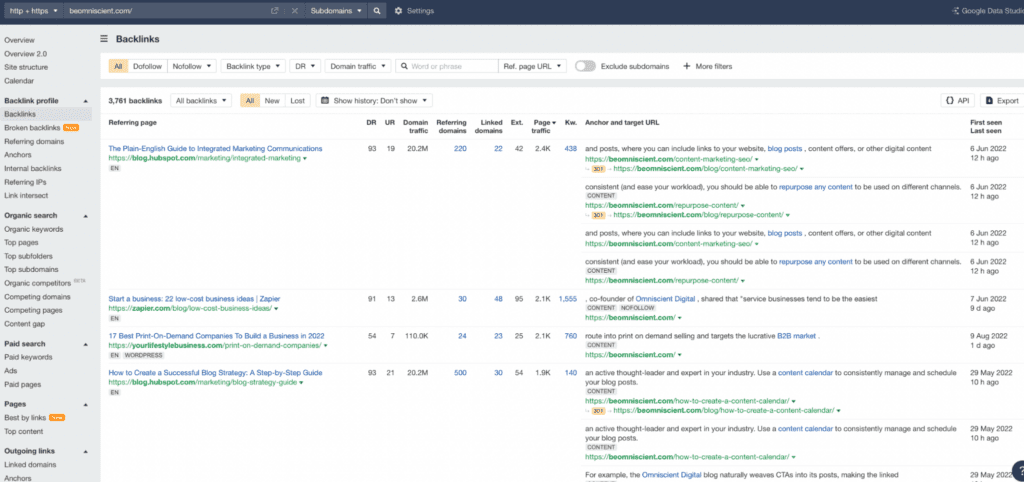
4. Identify Your Core Channels
Ramit Sethi has this great article called “go where the fish are.” Essentially, it’s about focusing on the channels and content types that will be most effective for your business.
Fun fact: this is also the model Scott Tousley used to hire me at HubSpot back in the day.
Identify the channels first, and then you can figure out tactics within those channels that work (and experiment with new tactics as you evolve).
Then, within specific channels, you can get even more granular. For instance, communities as a channel is quite broad. Figure out which specific Facebook, LinkedIn, and Slack communities are the most propitious for your promotion goals.
Tactics exist within each of these as well. For instance, on the blogging front, you’ve got content syndication, guest blogging, email marketing, and the ability to repurpose content to social channels.
For podcasting, you can start your own podcast, become a guest on others’ podcasts, repurpose content from the podcast to other mediums, etc.
This makes sure you’re not wasting a ton of time and effort promoting on channels that don’t even matter. If you’re selling B2B enterprise software to CIOs, maybe Facebook isn’t the easiest channel. Maybe you’re better off creating content for LinkedIn.
You have to have a deep understanding of where your audience goes for information (and also, who they trust as influencers).
If you want to catch fish, go where the fish are. I like to build a distribution channel matrix that includes dimensions like total reach, targeting potential, saturation, and ease / cost. This helps me prioritize my efforts across the thousands of content distribution options today.
Reforge has a great model for choosing acquisition channels in general, which you can apply to your content promotion channels.
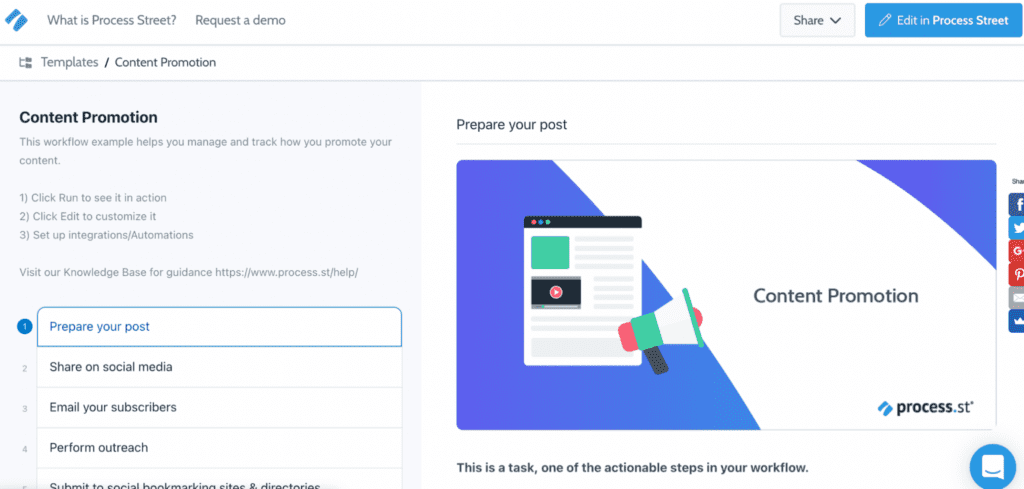
Note: it’s best not to dilute your efforts. As Robert Greene says, “concentrate your forces.” It’s better to double down on one or two channels that to try to be “everywhere.”
5. Index on Long Term and Short Term Channels
A great content promotion strategy accounts for both short term traffic spikes as well as plans for long term, compounding efforts.
Short term spikes look like this:
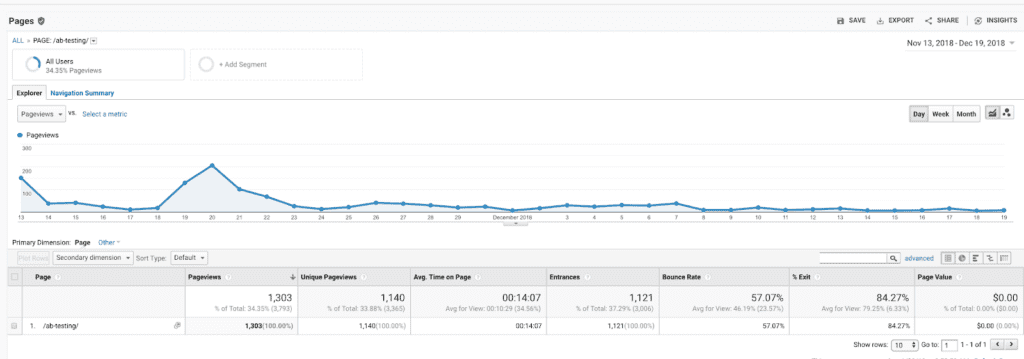
Long term growth looks like this:

Almost always, your long term channels will be SEO or email marketing. SEO is one of those things that takes a while to kick in, but when it does, it’s quite stable. Similarly, email is an “owned channel.” Sure, some subscribers will churn, but for the most part, you’ve got a captive audience that has opted in to hearing your work.
In my opinion, your strategy should be primarily focused on these.
However, especially in the early days of a content marketing program, you’ll need short term traffic spikes as well to make sure your content actually gets traction.
This is where you can get much more creative and figure out what works with your particular strengths and target audience.
Much of the time, these short term spikes come from social media marketing. We, for instance, index heavily on Twitter and LinkedIn. For you it might be YouTube, TikTok, Facebook, Instagram, or a cool new social media network I haven’t heard of.
You can also email influencers and people quoted in the article to get distribution from the content itself. Simple outreach, when done well, is still quite effective.
In fact, no matter what channel you’re using, getting good at outreach will be important. This is true whether you’re asking bloggers if you can write a guest post, or whether you’re trying to get included in an influencer’s email newsletter.
Side note: please don’t use a canned email template. Write personally and with heart. There’s too much noise in everyone’s email inbox.
Others love Quora and Reddit, though I haven’t quite figured those channels out.
Don’t ignore forums and private communities like Slack groups either. While it’s hard to promote your content blatantly, if you’re a member of the community and provide constant value, these can be some of the highest leverage channels available to you.
If you’ve got the budget, PPC (pay-per-click) and paid marketing can also be an effective way to distribute content, particularly if it’s insanely valuable content and gated. This is a common way B2B marketers use LinkedIn.
6. Incorporate your promotion strategy into your content calendar
Most content marketing programs are run using an editorial calendar or content calendar.
This is basically a project planning and project management tool to make sure nothing slips through the cracks.
In a similar way, you should map out your core content promotion activities.
With link building, that’s easy enough to do. You set your goal of N links per month, which you can trace back to a certain number of outreach emails sent and guest posts published.
With other channels, you can treat them just like any other publication calendar. For instance, I map out my own LinkedIn publication calendar (using Hypefury for automation and Airtable for management) to produce 5X posts per week.
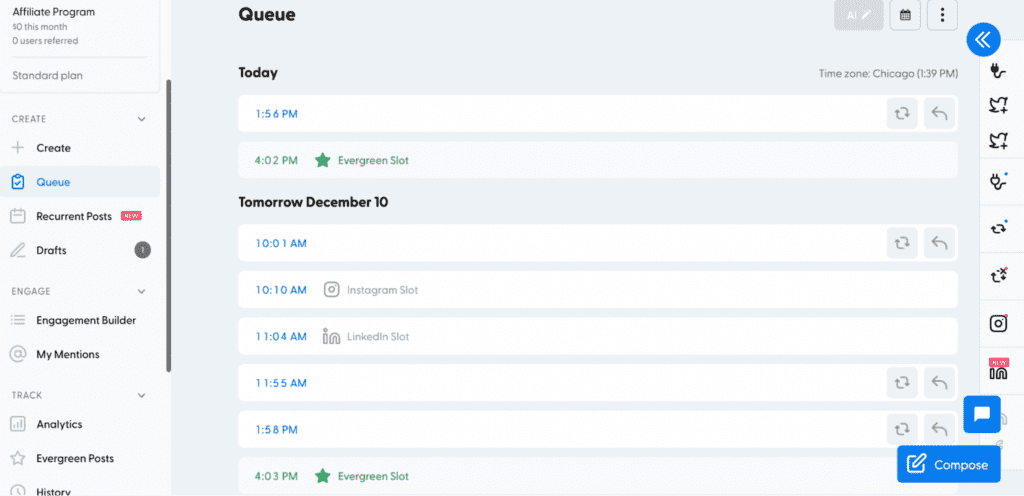
I treat this just like my blog post calendar.
You can use a tool like Trello or Google Sheets to create an effective editorial calendar. This way, everyone on your content team will know exactly what content needs to be created and promoted and when.
There are some content promotion activities you can’t predict, such as the exact number of social shares a piece of content will get on a given social network.
But you can operationalize all the inputs that predict those things into your workflow. Which…
7. Map Out Your Basic Workflow
I kind of talked smack before on the idea that content promotion is as simple as a checklist.
What I said is true – content promotion strategy is a fundamental component of your content strategy and can’t merely be reduced to a checklist.
HOWEVER…I love checklists.
And I think you should make a content promotion checklist.
It’s just that it shouldn’t a a to-do list of every single minute way to potentially spread your content. For example:
Post blog on Twitter- Facebook ad campaign to ebook
- Repurpose podcast to video content
What I like to do is include a checklist on my Airtable card for each blog post or podcast (or whatever your “core” content asset is – could be an ebook or whatever).
The checklist should associate specifically to the types of content produced. For example, an infographic can be promoted differently than a podcast or a series of webinars.
You can also use a standalone workflow management tool like Process Street, or any other tool you find suitable for your needs.
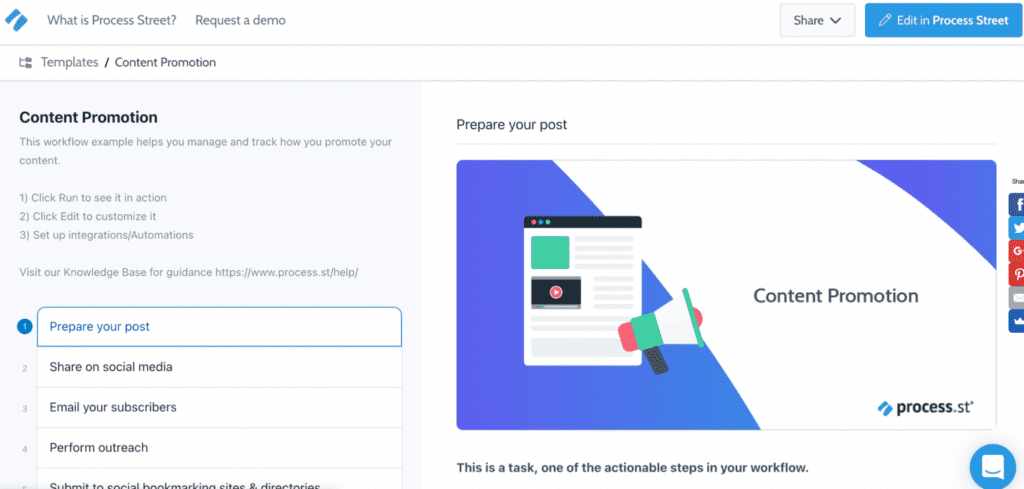
8. Set Up Tracking and Reporting
I’m a big believer in analytics, measurement, and tracking your results.
Sure, I’ll give you this: not everything in content marketing can be tracked.
That applies especially to content promotion, where many social shares may be “dark social,” or untrackable because they’re shared in Slack channels or messaging apps.
But…whatever. You should still track key input and output metrics.
At a high level, your content marketing program should be measuring leads generated, conversions, or whatever your core KPI is (sometimes it’s product signups, email signups, demo requests, MQLs, etc.).
Track CTA (call to action) clicks, too. Why not? Helps you figure out which piece of content is performing and which isn’t.
Then measure your efforts and ROI with content promotion as well. It’s hard to measure the concrete output or value of a given backlink, but you can track link velocity, relevance (subjective), domain rating (DR), cost per link, and number of links.
You can track passive link acquisition, too.
Google Analytics is great for the website metrics you can track, but you may have to come up with separate ways to track things like link building (perhaps email outreach metrics on your tool of choice).
The thing about tracking is it’s so specific to your content marketing strategy. If you goal is to get thought leaders to share your content, for instance, you can invest in a social analytics tool like Buzzsumo, and perhaps even isolate out the influencers that are sharing it.
Anyway, got a whole piece for you on content analytics here if you’re a nerd.
9. Experiment and optimize
Content promotion is an ever-evolving process and it’s important to continually experiment and optimize. This can include trying out new content formats, content promotion channels, tracking metrics, etc.
Keep a close eye on your analytics data and use it to inform decisions about content creation and content promotion strategy. With enough experimentation you will eventually find the content promotion formula that works for your business.
10. Rinse and repeat!
Once you have the content promotion formula nailed down, it’s time to rinse and repeat. Make sure that content creation is always at the forefront of your content strategy and that content promotion activities are being executed on schedule.
Conclusion
Now you know how to create an effective content promotion strategy that will help you reach your business goals.
Your strategy should be unique to you, but to build it, follow these steps:
- Start with your goals
- Understand your audience
- Research your competitors
- Identify the right channels for promoting your content
- Incorporate promotion into your content calendar
- Map out a workflow
- Set up tracking and reporting
- Experiment and optimize along the way
..and, you know, just keep going. Results take time. Play fast, but be patient. High-quality content doesn’t promote itself.



